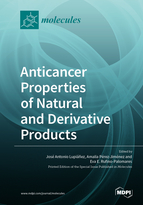Anticancer Properties of Natural and Derivative Products
A special issue of Molecules (ISSN 1420-3049). This special issue belongs to the section "Natural Products Chemistry".
Deadline for manuscript submissions: closed (30 November 2020) | Viewed by 63141
Special Issue Editors
Interests: study of the anticancer potential of natural and derivatives products derived from the olive grove; molecular pathways involved in anticancer processes; glucose metabolism and its regulation; enzimology and kinetics; biochemical characterization of anti-inflammatory and anti-oxidant properties; proteomics and metabolomics associated with cancer; cell growth processes: protein synthesis and degradation
Special Issues, Collections and Topics in MDPI journals
Interests: animal welfare; aquatic toxicology; functional molecules; natural compounds; oxidative stress and immunology
Special Issues, Collections and Topics in MDPI journals
Interests: anticancer bioactivities of natural products; functional proteomics; gene regulation by microRNAs; molecular characterization during inflammation and oxidative stress
Special Issues, Collections and Topics in MDPI journals
Special Issue Information
Dear Colleagues,
This Special Issue aims to collect and disseminate some of the most significant and recent contributions in the use of natural and derivative compounds to cancer prevention and treatment. Natural products are bioactive compounds synthesized by terrestrial and marine plants, microorganisms, and animals. Traditionally, they have been used in the prevention and treatment of various human diseases in different cultures. In parallel, chemical derivatives of these natural compounds have been used in order to enhance their bioactivities. During the last ten years, most of them have been reported to have a variety of interesting and significant biological properties, such as analgesic, anti-allodynic, antidiabetic, antioxidant, antiparasitic, antimicrobial, antiviral, anti-atherogenic, anti-inflammatory, antiproliferative, antitumor, and growth-stimulating activities as well as cardio- and neuroprotective activity. Special attention has been focused on the study of their antitumor capacity through the potential modulation of cancer initiation and growth, cellular differentiation, apoptosis and autophagy, angiogenesis, and metastatic dissemination. Moreover, a considerable number of studies have related their anticancer effects with their anti-inflammatory and antioxidant activities. Reports on the biological activity of natural extracts will only be considered if they are accompanied with proper chemical characterization.
Prof. Dr. José Antonio Lupiáñez
Dr. Amalia Pérez-Jiménez
Dr. Eva E. Rufino-Palomares
Guest Editors
Manuscript Submission Information
Manuscripts should be submitted online at www.mdpi.com by registering and logging in to this website. Once you are registered, click here to go to the submission form. Manuscripts can be submitted until the deadline. All submissions that pass pre-check are peer-reviewed. Accepted papers will be published continuously in the journal (as soon as accepted) and will be listed together on the special issue website. Research articles, review articles as well as short communications are invited. For planned papers, a title and short abstract (about 100 words) can be sent to the Editorial Office for announcement on this website.
Submitted manuscripts should not have been published previously, nor be under consideration for publication elsewhere (except conference proceedings papers). All manuscripts are thoroughly refereed through a single-blind peer-review process. A guide for authors and other relevant information for submission of manuscripts is available on the Instructions for Authors page. Molecules is an international peer-reviewed open access semimonthly journal published by MDPI.
Please visit the Instructions for Authors page before submitting a manuscript. The Article Processing Charge (APC) for publication in this open access journal is 2700 CHF (Swiss Francs). Submitted papers should be well formatted and use good English. Authors may use MDPI's English editing service prior to publication or during author revisions.
Keywords
- angiogenesis
- cancer
- chemoprevention
- inflammation
- molecular pathways
- natural and derivative products
- oxidative stress









